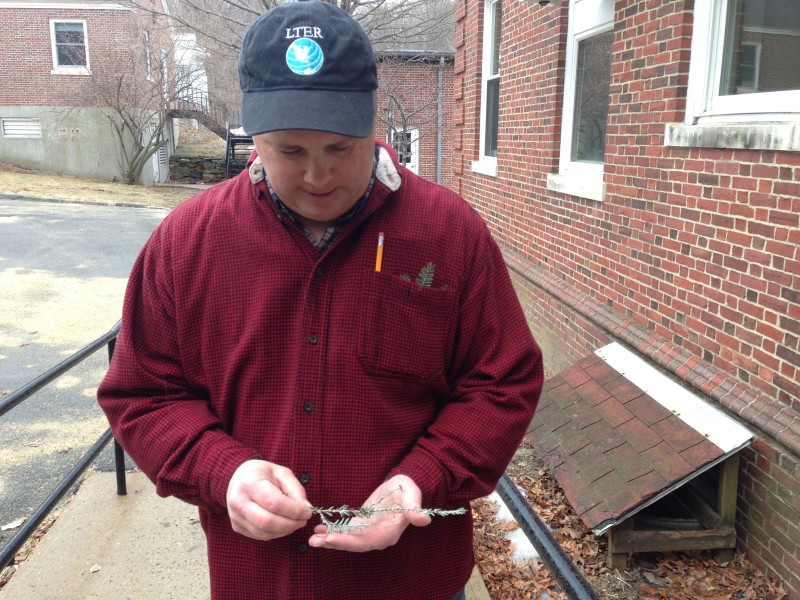ODE TO HEMLOCK
As I look around me, I cannot believe these grand trees, reigning supreme here for 8,000 years, are being taken out by a tiny bug, no bigger than a pencil point. But it is true: the hemlocks are dying.
The Hemlock Hollow is a special place to me in the Harvard Forest. The sun lights its fresh green canopy year round, brightening the somber palette of winter. By May, as the humidity starts to cling close, walking into the Hemlock Hollow, as we call this green glade, is pure refreshment; it feels ten degrees cooler in here. The softness of the needles underfoot is distinct. Slow to decompose, the needle litter builds up, getting softer and thicker year upon year. Piled many inches deep, it feels plush and springy as a mattress. It was the Hemlock Hollow that convinced me to switch from hiking boots to thin-soled shoes for my forest walks, so I could savor the many different textures and depths of the forest floor – and especially the deluxe cushy carpet of the Hemlock Hollow.

Hemlocks dominate their realm, shading out plants in the understory. The result is a park-like grove uniquely pleasant for walking.
The Hemlock Hollow, like any hemlock grove, is also an ecologically distinct and special place. Because the canopy captures nearly all of the sun’s light, the forest floor is a place of rare sun flecks where only the most shade tolerant plants can eke out a living. The result is a park-like grove, with clear sight lines across the understory beneath a nearly sealed canopy. It’s part of the unique feeling of being in this part of the forest, with a sense of both aspect and refuge.
There is a special quality to the light and presence of this part of the forest that no photo seems entirely to capture. Year-round, the hemlocks’ feathery, soft, flexible needles and branches that begin low on their trunks interlace to create a canopy that locks the understory into deep, velvety shade.

The ability of hemlock boughs to trap snow provides refuge from deep drifts that are important to wildlife, especially deer.
Hemlocks dominate their realm. Monarchs of shade, they set the temperature, the water regime, the soil chemistry and determine the suite of life that will share their domain. The Hemlock Hollow is a place of quiet things: salamanders on their earnest travels, a vernal pool that draws wood frogs for their urgent errand to breed in early spring, then dispersing as mysteriously as they arrived.
As Harvard Forest researchers so engagingly write in their book, Hemlock, A Forest Giant on the Edge, in this particular grove, for some 8,000 years, hemlock have made the rules. They have flourished here in a triumphant return after mysteriously dying out, the pollen record shows, some 5,500 years ago. Hemlock then recovered almost completely, after a period of regional scarcity that lasted 1,500 years. Poignantly, hemlock regained their reign only to now once again face mortal threat.
First reported in the US in Virginia 1951, hemlock woolly adelgid is a small, aphid-like insect on the march. In New England, it attacks and gradually kills eastern hemlock by draining their vital juices through a small sucking mouthpart. Even a large healthy hemlock can be killed in ten years. Already millions of hemlocks have been infested, from Georgia to southeastern Maine, and in the Harvard Forest, too, the hemlocks are already dying by degrees. There is more sun here now than there should be, more open sky, too many needles on the snow in winter. In spring, instead of a season of robust fresh growth, there is a death rattle of needles raining to ground.

Hemlock wooly adelgid can kill a healthy hemlock in less than ten years. This hemlock at the Harvard Forest was healthy five years ago. Photo by David Orwig.
David Orwig, a senior forest ecologist at the Harvard Forest studies the effects of the adelgid at the forest and throughout southern New England. He came in from a walk in the forest today with a few springs of hemlock in his pocket. Climate change has helped adelgid advance in their range further and further north. The discouraging thing is that even after a cold winter just passed with some days of temperatures dipping below zero, the adelgid are still thriving. He pulled a branch from his pocket and flipped it over to show me: It was covered with the telltale white cottony casings of adelgid that will soon begin laying eggs, reproducing not once, but twice in a season. The insects don’t have wings, but instead are carried on the wind, from tree to tree.

David Orwig, a senior ecologist at the Harvard Forest, back from a walk today surveying the Hemlock Hollow. Orwig holds a sprig of hemlock in his hand — and another in his pocket.
In a forest, there is no practical defense against the adelgid’s incessant spread. So instead, at the forest the approach is to study the demise of a tree that so dominates its realm. What happens to the forest? To the stream flows, the animals and understory plants? To learn how the forest will respond as hemlock wooly adelgid take their toll, researchers in 2005 girdled every hemlock in a long-term ecological research plot. They have since been watching these hemlock die, and counting the stems of the trees that come back to take their place, to understand what forests of the future here might look like. A companion plot was commercially logged, to see the difference in response between the gradual death inflicted by the bug, compared with the more familiar response to a commercial–style harvest. I walked the ghostly girdled trees in the hemlock removal experiment with Audrey Barker Plotkin, a senior research scientist at the Harvard Forest one afternoon last autumn, chalking every stem as we counted it. It seemed the only thing I recorded was black birch in a thick forest of new young trees springing up under the grey visage of the dead hemlocks. Hemlock’s loss, at least at this point, is looking like black birch’s gain.

Hemlock woolly adelgid — the white dots –infest this hemlock twig Dave Orwig brought back from the Harvard Forest today. The long cold winter hasn’t slowed down the invasive pest.
After these hemlocks fall, this will still be a forest. But it won’t be the forest I have come to know and love; that special cool refuge on hot days, quiet and deliciously dim, like an air-conditioned library with the shades drawn. And what of the refuge it provides in winter for animals – for deer seeking respite from deep snows, the porcupine seeking a resting spot in its dense branches, or a tasty snack of its nutritious branch tips?
I recently visited the Hemlock Hollow, to enjoy its winter beauty, and the quiet swoosh of its boughs, like the sound of a seashell cupped to the ear. It won’t be the same here in winter, with sun streaming through the canopy of deciduous trees that will move in after the hemlocks are gone. And so this bit of forest now so special, unto itself, will look like the forest everywhere else. A bit of diversity of the native New England wood will be gone. A deep bass note will be lost in a symphony that has played for 8,000 years.

Penning notes for this post on a recent winter afternoon, while sitting on a log at the Hemlock Hollow. I will miss hemlock.

Leave a Reply